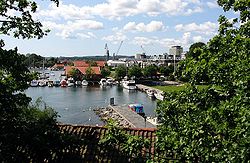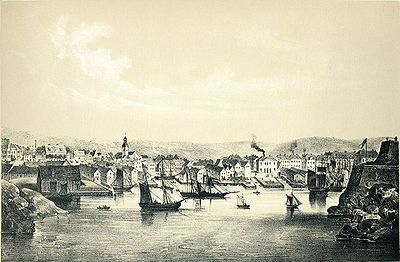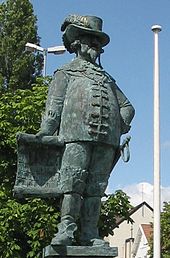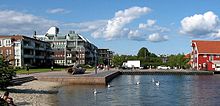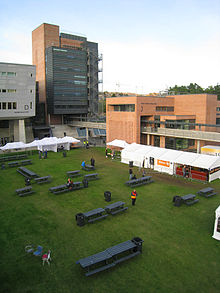- Kristiansand
-
Kristiansand kommune — Municipality — Part of the city of Kristiansand seen from Christiansholm Fortress 
Coat of arms
Vest-Agder within
NorwayKristiansand within Vest-Agder Coordinates: 58°10′12″N 8°0′22″E / 58.17°N 8.00611°ECoordinates: 58°10′12″N 8°0′22″E / 58.17°N 8.00611°E Country Norway County Vest-Agder District Sørlandet Administrative centre Kristiansand Government - Mayor (2011) Arvid Grundekjøn (H) Area - Total 277 km2 (107 sq mi) - Land 259 km2 (100 sq mi) Area rank 287 in Norway Population (2009) - Total 82,770 - Rank 5 in Norway - Density 291/km2 (753.7/sq mi) - Change (10 years) 10.9 % Demonym Kristiansander[1] Time zone CET (UTC+1) - Summer (DST) CEST (UTC+2) ISO 3166 code NO-1001 Official language form Bokmål Website kristiansand.kommune.no Data from Statistics Norway
 Kristiansand (help·info)[2] (formerly "Christianssand") is a city, municipality and the county capital of Vest-Agder county in Southern Norway. Kristiansand municipality is the 5th largest in Norway with a population of 82,562 as of 1 April 2011. The Kristiansand urban area, entirely located in the municipality, had a population of 67,547 on 1 January 2009, and is thus the 8th largest urban area in Norway. In addition, the Statistics Norway (no:Statistisk Sentralbyrå) counts that there are 4 other densely populated areas in the municipality: Skålevik (Flekkerøy) with a population of 2,635, Strai (Torridal) with a population of 1,332, Justvik with a population of 1,613 and Tveit with a population of 1,390 citizens (January 2009).
Kristiansand (help·info)[2] (formerly "Christianssand") is a city, municipality and the county capital of Vest-Agder county in Southern Norway. Kristiansand municipality is the 5th largest in Norway with a population of 82,562 as of 1 April 2011. The Kristiansand urban area, entirely located in the municipality, had a population of 67,547 on 1 January 2009, and is thus the 8th largest urban area in Norway. In addition, the Statistics Norway (no:Statistisk Sentralbyrå) counts that there are 4 other densely populated areas in the municipality: Skålevik (Flekkerøy) with a population of 2,635, Strai (Torridal) with a population of 1,332, Justvik with a population of 1,613 and Tveit with a population of 1,390 citizens (January 2009).Contents
The name
The city was named after its founder King Christian IV in 1641. The last element sand refers to the sandy headland the city was built on (see also Lillesand).
The name was written "Christian(s)sand" (for "Christians sand" - meaning en:[King] "Christian's Sand") until 1877 - then, according to an official spelling reform (that changed ch to k), the form was changed to "Kristianssand". (See also the names Kristiansund and Kristiania that were affected by the same reform.) The name was again changed to its present form Kristiansand in 1889.
Coat-of-arms
The arms were granted on 8 December 1909 and are based on the oldest seal of the city, dating from 1643. In 1643 King Christian IV (of Denmark and Norway) granted the young city the right to use a seal with the Norwegian lion and the Royal crown. The crown indicates that the city was founded by the king. As the species of tree is not properly described, there are several images known with differently shaped trees. A second seal, from 1658, shows a tree with leaves and what looks like pine cones.[3]
Geography and climate
-
The river Otra runs through Kristiansand
-
River mouth of Tovdalselva, next to Kristiansand Airport, Kjevik
Kristiansand and the Agder counties usually have a lot of summer sunshine compared to most of Norway. There may be heavy snowfall in winter with south-southeasterly winds (snow record at Kjevik is 170 cm), but the snow rarely stays long at the coast; see climate.
In the summer most locals go to the Fish Market, the Archipelago and Hamresanden Beach which is located near Kjevik airport (about 10 mins from the city centre). People from Denmark, Sweden, Germany, the UK and other European countries also visit this beach in the summer during their travels.
Near the city, there are deep woods. In Baneheia and at the previous Coastal artillery Fortress Odderøya, there are lighted ski trails and walking paths specially prepared for Wheelchair users.
Two major rivers, Otra and Tovdalselva have the river mouths into Skagerak in Kristiansand.
Climate data for Kristiansand (1961-90) Month Jan Feb Mar Apr May Jun Jul Aug Sep Oct Nov Dec Year Average high °C (°F) 1.3
(34.3)1.9
(35.4)4.4
(39.9)8.9
(48.0)14.3
(57.7)18.6
(65.5)20.1
(68.2)19.3
(66.7)15.6
(60.1)11.4
(52.5)6.2
(43.2)3.0
(37.4)10.4 Average low °C (°F) −4.8
(23.4)−5.1
(22.8)−2.2
(28.0)0.7
(33.3)5.6
(42.1)9.4
(48.9)11.1
(52.0)10.4
(50.7)7.8
(46.0)4.7
(40.5)0.2
(32.4)−3.4
(25.9)2.9 Precipitation mm (inches) 121
(4.76)80
(3.15)87
(3.43)59
(2.32)86
(3.39)75
(2.95)88
(3.46)118
(4.65)141
(5.55)164
(6.46)164
(6.46)116
(4.57)1,299
(51.14)Avg. precipitation days 19 15 16 12 14 12 13 17 18 19 20 19 194 Sunshine hours 56 89 135 187 246 280 257 213 153 96 50 33 1,795. Source no. 1: World Weather Information Service[4] Source no. 2: climatedata[4] History
As indicated by archeological findings in the city, the Kristiansand area has been settled at least since 400 AD. A royal farm is known to have been situated on Oddernes as early as 800, and the first church was built around 1040. The first settlements near the modern city were located further down the river, in or near what is today the borough of Lund, and at Flekkerøy, an island outside the city centre.
Kristiansand was formally founded by King Christian IV in 1641. It was created as a market town to encourage growth in a strategically significant area, providing a local economic base for construction of fortifications and population for defence of the area. The centre of Kristiansand, in layout essentially unchanged since the 17th century, is called "Kvadraturen" due to its square gridline of streets.
The city experienced its first major town fire in 1734, when large parts of the city was destroyed. Kristiansand grew into a major port during the 18th century, both due to its expanding ship building industry and its trade fleet. The city burned again in 1892. As a neutral trade port, the economy of Kristiansand thrived during World War I, but the growth stagnated due to political decisions and the Great Depression of the late 1920s and 1930s.
Kristiansand was established as a municipality 1 January 1838 (see formannskapsdistrikt). The rural municipalities of Oddernes, Randesund and Tveit were merged with Kristiansand on 1 January 1965.
Demography
Historical populations Year Pop. ±% 1951 25,797 — 1960 27,760 +7.6% 1970* 56,119 +102.2% 1980 60,738 +8.2% 1990 64,888 +6.8% 2000 72,395 +11.6% 2007 77,840 +7.5% 2008 78,919 +1.4% 2009 80,109 +1.5% Source: Statistics Norway. * merged with suburban municipalities in 1964. Culture
The Quart festival, held every year at the beginning of July, is back in 2009 after financial difficulties that saw it close in 2008. As Norway’s biggest music festival, Quart has taken place in Kristiansand every July since 1991. Originally named Qvadradurmusivalen, its name was changed to the more catchy Quart Festival the following year. For several years Quart was the largest music festival in Norway, but has struggled in recent years in part due to tough competition from the Hovefestivalen in Tromøya, Arendal and some Oslo based festivals. The rock music event lasts for five days and has concerts on a big stage in Oderøya, a peninsula south of the town centre, as well as on smaller stages around the town. Quart is known for attracting famous international artists to Kristiansand each year as in addition to finding new young talents, for whom performing in Quart meant a fast and steady track to fame. Many of today’s big stars previously appeared on Quart’s smaller stages. The line-up for the revitalized Quart Festival 2009 includes world-famous stars, such as Ozzy Osbourne, Fergie, The Black Eyed Peas, Marilyn Manson and Placebo.
Kristiansand is a home to many other festivals as well. A noteworthy example is the Protestfestival. It was launched in 2000 and takes place every September. Protestfestival aims to address apathy and indifference in politics, and is often referred to as "the small festival that asks the big questions". Debates, concerts and lectures are held at the festival combined with performance art and documentaries. Protestfestival claims to attract anarchists, communists, hippies as well as conservative Christians and capitalists and encourage communication among these radically different groups.
Festivals run throughout the year in Kristiansand. Some of these include the Bragdøya Blues Festival in June, the Dark Season Festival in October, Cultural Night and the International Children Film Festival in April. Kristiansand has an active music scene as well. The Kristiansand Symphonic Orchestra as well as Chamber Orchestra and Wind Ensemble are now well known after their merging in 2003. The new Concert Hall “Kilden” is planned to be finished in Kristiansand in 2011. So far concerts take place in Agder Theatre, which is also a venue for most of the other big events. South Norway’s Art Museum is also in the centre of Kristiansand. It was established in 1995 and is the second biggest regional art museum in Norway.
The museum runs an extensive programme, which includes exhibitions of the permanent collection, temporary contemporary art-exhibitions and touring exhibitions to schools and child-care initiatives. The museum is working to generate interest, engagement, knowledge and understanding of the arts, crafts and other visual arts.
Cultiva, which is a local government foundation, was established to ensure a portion of the profits made from selling shares in Agder Energy Ltd have lasting benefits to the community, with some of the money invested in cultural projects in Kristiansand. In addition, in 2007 Kristiansand won cultural funding from “Norges kulturkommune”, which was established by the Norwegian Culture Forum and is awarded every other year. Fiskebrygga, in Kristiansand, is very popular in summer. In the 1990s the area was refurbished transforming the traditional landing area for boats with restaurants and shops.
The City’s famous football team, IK Start, had their final home game at Kristiansand Stadium in 2006. As of 2007 the team has been moved to its newer facilities in Sør Arena. Kristiansand is also known for its handball teams (KIF and Kristiansand Vipers), basketball (Kristiansand Pirates), volleyball club (Grim VBK) and baseball team (Kristiansand Suns). Kristiansand Suns is commonly known as the morale winners of the NM 2010.
The zoological garden, Kristiansand Dyrepark (Kristiansand Zoo and Amusement Park) just east of the city, has a wide selection of animals in, for the most part, natural habitats. This includes animals such as wolves, tigers, lions and the lynx. The Dyreparken draws many tourists and is the second most visited in Norway. The zoo is open 365 days while the amusement park is open during the summer season only.
Agderforskning (Agder Research) is an interdisciplinary social science research institute based in Kristiansand. As well as broad involvement in festivals, Agderforskning is also working on projects connected to value creation in coastal culture, cultural heritage, film and travel and tourism production, cultural experience surveys, cultural activities financing, interaction and innovation processes connected to art in the workplace, cooperation in the tourism industry, experiential tourism, entrepreneurship in the music industry, and dialogue-based innovation where art, culture and commerce meet. Although strongly based in the Kristiansand and the surrounding area, their studies are far reaching; nationally, throughout Scandinavia and in Europe in the development of international research projects. More information about their most recent project on festivals is on the website www.festivals.no.
Economy and transport
Kristiansand is connected to continental Europe by air and sea. The local airport, Kjevik, is located 12 km (7.5 mi) east of the city and has routes to European and Norwegian cities. From the city centre, the ferry harbour has routes to Hirtshals (Denmark) and Hanstholm (Denmark). Road connections goes via E18 east to Arendal and Oslo, via E39 west to Mandal and Stavanger, and highway 9 north to Vennesla, Setesdal and Haukeli. The Sørlandsbanen railway has station in downtown Kristiansand which is a terminus station, where trains have to change direction. Trains go east to Oslo and west to Stavanger.
Kristiansand has major shipbuilding and repair facilities that support Norway's North Sea oil industry. Near Kristiansand there is the static inverter plant of the HVDC Cross-Skagerak.
Education
The University of Agder's largest campus is located in Kristiansand; the university itself has about 8,000 students. Formerly a university college, it was granted status as a university on 1 September 2007. Study programs include business and economics, engineering and technology, the humanities, mathematics, nursing, teacher education, as well as fine arts.
Kristiansand is also home of one of the BI Norwegian Business School's (Norwegian: Handelshøyskolen BI) campuses, in addition to The Gimlekollen School of Journalism and Communication (Norwegian: Mediehøgskolen Gimlekollen), which offers degrees in journalism and communication.
In 2006, 27% of those above 16 years in Kristiansand had higher education, compared to the national average of 24.2%.
People from Kristiansand
Further information: Category:People from KristiansandSee also
External links
- Municipal fact sheet from Statistics Norway
- Vest-Agder travel guide from Wikitravel
- Kristiansand travel guide from Wikitravel
- Kristiansand Virtual Tour, 360* Panoramic Pictures (QTVR)
- Visit Kristiansand website
- The Official Website of the Kristiansand Region
- Explore the Kristiansand Region
- Regional tourist information
- Kristiansand - a flourishing city
- Kristiansand, summer VIDEO
- Port of Kristiansand
- Only Ski field in Kristiansand - also in English
- Tall Ships Races 2010
References
- ^ "Personnemningar til stadnamn i Noreg" (in Norwegian). Språkrådet. http://www.sprakrad.no/nb-no/Sprakhjelp/Rettskrivning_Ordboeker/Innbyggjarnamn/.
- ^ Even though the names are different, Kristiansand is often noted as Kristiansand S (S for South) to distinguish it from Kristiansund, also in Norway, in such cases noted as Kristiansund N. The practice originated before postal codes were introduced, as mail sometimes was sent to the wrong city. Occasional mix-ups with the Swedish city of Kristianstad have also been known to happen.[1]
- ^ Norske Kommunevåpen (1990). "Nye kommunevåbener i Norden". http://www.ngw.nl/int/nor/k/kristian.htm. Retrieved 27 September 2008.
- ^ a b "Weather Information for Kristiansand". World Weather Information Service. http://www.worldweather.org/008/c00908.htm#climate. Retrieved 1 January 2009.
Municipalities of Vest-Agder 
40 most populous urban settlements (cities) of Norway 37. Nesoddtangen 11,600 38. Steinkjer 11,500 39. Leirvik 11,400 40. Vennesla 11,400 41. Kongsvinger 11,400 42. Stjørdalshalsen 10,800 1 Sarpsborg.Categories:- Populated coastal places in Norway
- Kristiansand
- Kristiansand region
- Municipalities of Vest-Agder
- Cities and towns in Norway
- Populated places established in 1641
- Port cities and towns in Norway
- Port cities and towns of the North Sea
Wikimedia Foundation. 2010.

